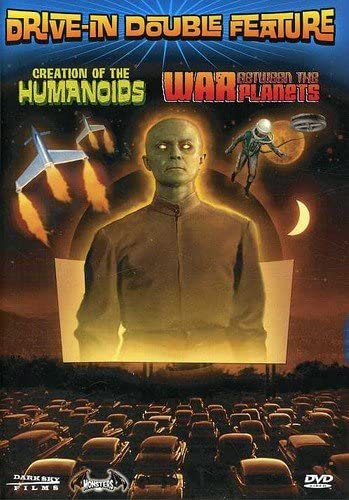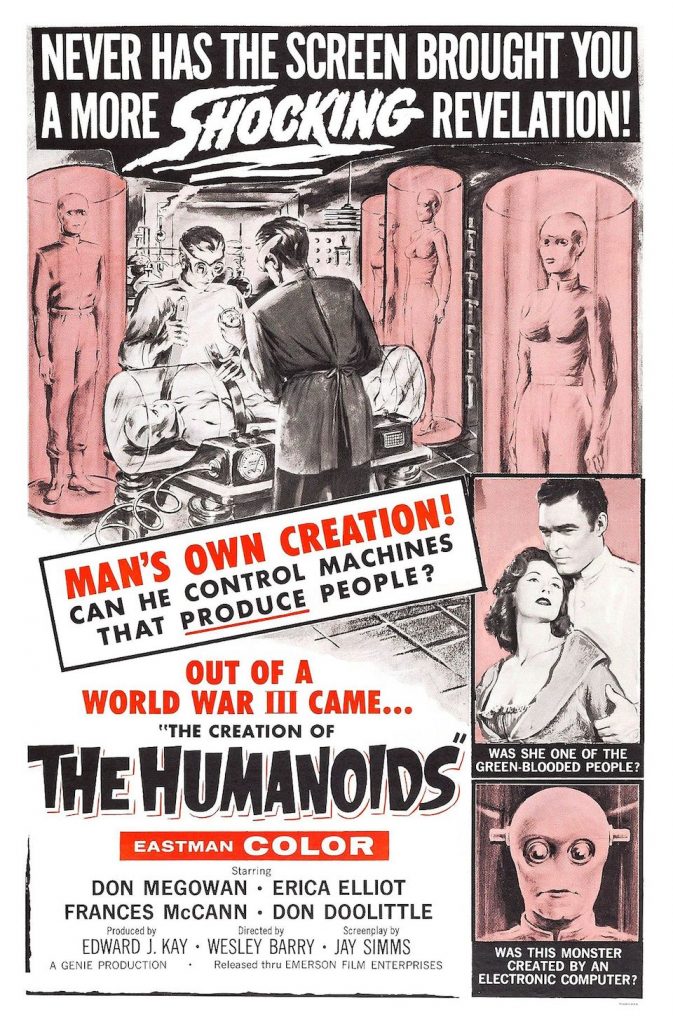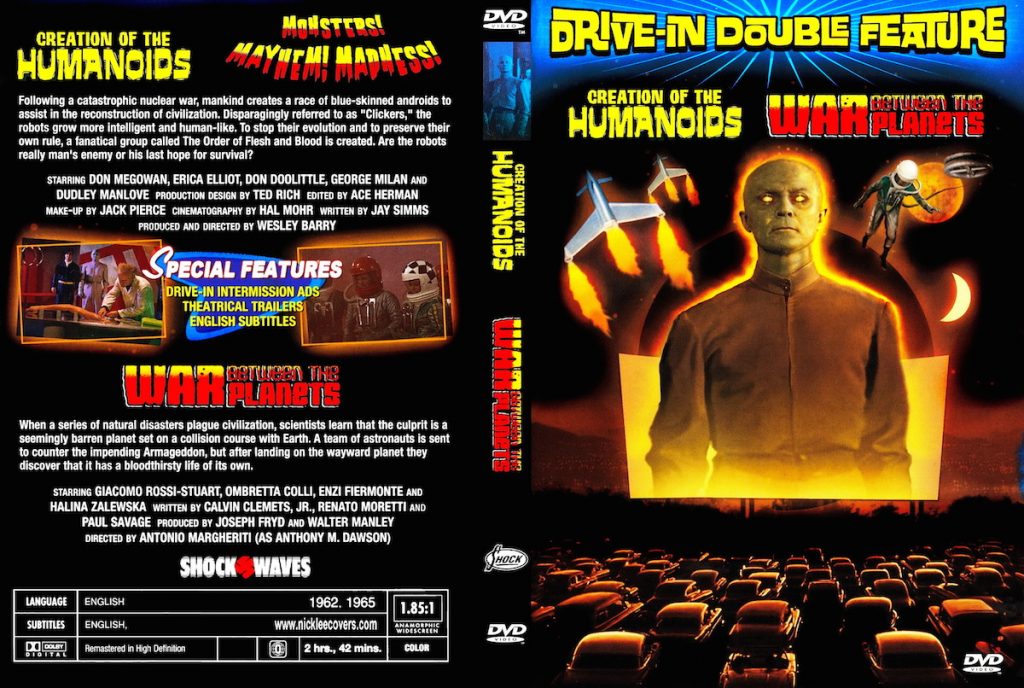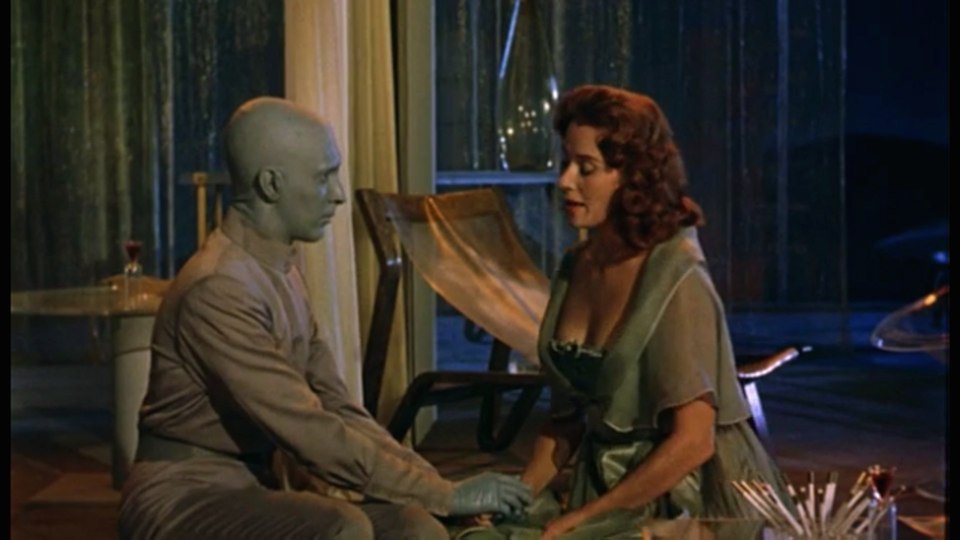
The Creation of the Humanoids (USA, 1962) 84 min color DIR: Wesley Barry. SCR: Jay Simms. PROD: Wesley Barry, Edward J. Kay. MUSIC: Edward J. Kay. DOP: Hal Mohr. CAST: Don Megowan, Erica Elliot, Frances McCann, Dudley Manlove. (Emerson Film Enterprises)
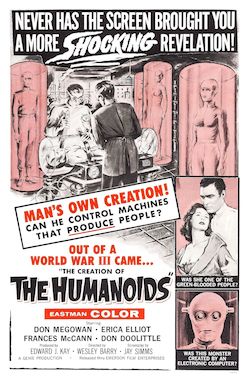
Warning: there is a huge spoiler ahead, but I can’t write this review without revealing it. If you’ve yet to see the movie and can handle the truth, read on. If you haven’t seen it, by all means check it out.
In the opening, we hear some unintelligible dialogue over blackness, followed by a long montage of mushroom clouds, and then some cheesy science film narrator explaining that someone dropped the bomb (“Who it was is of little importance now…”) and that the small population of surviving humans living underground created a series of robots to help with the work load. Then we are treated to a documentary (of something that hasn’t happened yet!) explaining all of the different models of robots that were created, each less machine-like than the last, until we finally the “present” model– these chalk-faced, dark-eyed silver clad humanoids. Thus begins the fascinating morality play of this zero-budget science fiction film, while short on visual ideas, is nonetheless bursting with good intentions on paper, which is why it remains a cult favourite.
Released during the middle of the Civil Rights Movement, this brave little fable is a thinly veiled allegory about equality, as the less-populated ruling class of humans (given the Totalitarian name, “The Order Of Flesh And Blood”) preside over the Humanoids, disparagingly referred to as “Clickers”, who stage a revolt. An old professor has developed a newer-looking model, with more realistic-looking flesh… And feelings. The humanoids kill him in order to expand on his invention. (Yes, they’re getting more human all the time.) Don Megowan (who looks like actor Don Gordon with a squint) as Captain Kenneth Cragis, is assigned to the case, and he must vie for the attentions of a woman who is attracted to a humanoid! At first we balk at this strange coupling, especially when it is mentioned that she was visited by a humanoid and became pregnant, but once we see the humanoid laugh, things get spookier.
Thematically, this stagy film is a feast. It is an early forerunner of William Gibson’s Cyberpunk fiction, and the screenplay is rampant with symbols of Fascism and Christianity! The robots are stopped by the human guards and asked for their identification just like any citizen would be under a dictatorship. It makes sense that there is little differentiation between the humanoid figures (except for body mass)– they are allowed no individualism or identity! Finally, both Man and Machine realize that there is no difference between each other, and agree to get along. Suddenly, this weird-looking scientist with a huge forehead whom we have seen throughout, turns towards the camera, and says “And so it came to pass. And that is why you are able to see this.”
What?!?
Wait a second– the story we just saw was how we were created? Therefore, what we think is the future was actually the past?!? This explains the strange documentary-like opening, and also when the old man turns to the audience at the end, he breaks through the fourth wall just like those guys on a Sunday afternoon TV special: “What you have just seen was a re-enactment of…”
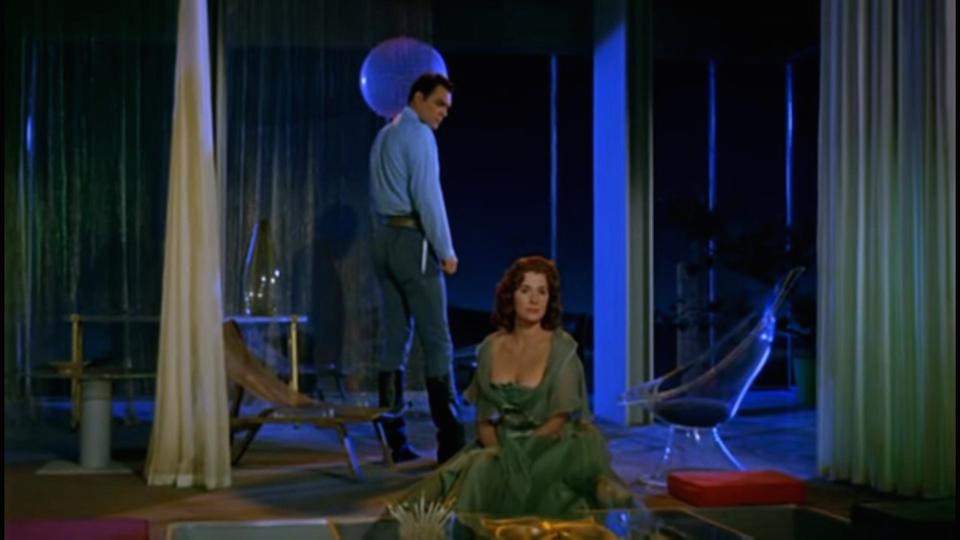
Your head swims when “The End” comes up– and it is followed by a definition from Webster stating that the end is the beginning of something else. Thus, this film is a collision of both Evolution and Creationism. Adam and Eve and The Big Bang Theory (remember the opening) are in the same fable. This also opens another potential idea: perhaps what happened prior to the opening was actually the universe before this one? This supports the theory that everything in the universe, from start to finish, happens again and again for all eternity– however, in this one instance, perhaps the two races learn from their mistakes and decide to prevent the future / the past from repeating itself? Whew.
This science-fiction film is so literate is because it has little else in production values. The film takes place entirely in these cramped, yet colourful interiors– this too, makes sense, as the outer world is probably still contaminated, and both human and robot must “get along” in this environment… And a synthetic environment at that! The limited mise en scene is helped immeasurably with a great electronic soundtrack by Edward J. Kay (this film’s co-producer, also a longtime movie composer), which gives the film a haunting atmosphere. Even though the action takes place entirely on a few sets, Hal Mohr’s cinematography brings out their secondary colours– the proceedings have an unsettling, 50s home-movie retro look (once you consider the ending, this pseudo-documentary feel makes sense). In the perverse scene where the Order Of Flesh And Blood convene– the men are lit with these hard keys, making them look more diabolical than the humanoids (who I guess would be a “special interest group” in today’s terms), and in behind them is a church-like stained glass window-a daring metaphor about a small group of people bringing their customs to a cultural mass that may not want them. No wonder this movie feels like a book.
The film has gained some notoriety as “Andy Warhol’s favourite movie” (which kind of makes sense, considering his own un-cinematic films), and has slowly gained a cult following over the years. Monterey Video released it to VHS, and Dark Sky Films released it to DVD, paired with War Between the Planets, as part of its Drive-In Double Feature series


